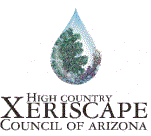

The High Country Xeriscape Council of Arizona is a non-profit 501 C-3 corporation dedicated to educating our communities about water-wise gardening. For additional information write:
HCXCA
4397 E AZ Highway 260
Payson, AZ 85541
Full Sun
Plant Name | Botanical Name | Height Inches | Description |
|---|---|---|---|
| Woolly yarrow | Achillea tomentosa | 2-4 | Grayish foliage in low mats. |
| Pussytoes | Antennaria spp. | 1-2 | Persistent gray-green foliage in dense mats; excellent for rocky slopes. |
| Sage | Artemisia spp. | 10-15 | Silvery foliage; A. schmidtiana (silver mound sage) most common. |
| Mat saltbush | Atriplex corrugata | 4-6 | Evergreen; foliage greenish-white; for salty soils. |
| Mountain bluet (perennial bachelor button) | Centaurea montana | 15-18 | Grayish foliage; blue flowers. |
| Snow-in-summer | Cerastium tomentosum | 6 | Gray foliage; white flowers; very aggressive. |
| Creeping broom | Cytisus decumbens | 4-8 | Green stems with tiny leaves; yellow, pea-like flowers in May. |
| Yellow ice plant | Delosperma nubigenum | 1-2 | Succulent, light-green foliage; yellow flowers. |
| Mock strawberry | Duchesnea indica | 4-6 | Aggressive creeper; looks much like strawberry; yellow flowers; inedible, red fruit. |
| Sulphur flower | Eriogonum umbellatum | 3-6 | Showy flower stalk to 8 inches tall; foliage in low mat. |
| Cushion spurge | Euphorbia epithymoides (polychroma) | 12-18 | Mounds of foliage that change from reddish to green in spring, then scarlet in fall. |
| Snow-on-the-mountain | Euphorbia marginata | 4-8 | Green and white foliage; very aggressive. |
| Blue fescue | Festuca ovina glauca | 6-8 | Tufts of grayish, grassy foliage. |
| Creeping juniper Some common clones include: 'Bar Harbor' 'Blue Chip' 'Hughes' 'Webberi' 'Wiltoni' ('Blue Rug') | Juniperus horizontalis | 10 10 10 4 4 | Perhaps the best year-round cover; many clones and foliage hues available. Blue-green; purplish winter color. Bluish foliage year-round. Silvery-blue; distinct radial branching. Very low mat; fine texture. Very low; silver-blue; purplish tinge in winter. |
| Pineleaf penstemon | Penstemon pinifolius | 6-10 | Has needle-like leaves and orange-red flowers; takes heat well. |
| Moss pink or creeping phlox | Phlox subulata | 6-8 | Reddish, white or lavender flowers; moss-like foliage. |
| Creeping potentilla | Potentilla verna | 1/2-1 | Very low mat with yellow, showy flowers; aggressive. |
| Creeping buttercup | Ranunculus repens | 1-2 | Yellow, showy flowers on creeping runners up to 2 feet long. |
| Lavender-cotton | Santolina chamaecyparissus | 10-12 | Blue-gray, persistent foliage in dense mats. |
| Stonecrop (sedum) | Sedum spp. | 1-15 | Many forms available; not usually competitive with weeds. |
| Houseleek, hen and chicks | Sempervivum spp. | 2-4 | Forms dense, evergreen mats; grows in very poor soils. |
| Mother-of-thyme | Thymus serpyllum | 3-6 | Low, mat-forming herb with tiny leaves; purple flowers; related species, woolly thyme, has gray-green foliage. |
Shade
| Plant Name | Botanical Name | Height (Inches) | Remarks |
|---|---|---|---|
| Bishop's weed | Aegopodium podagraria 'variegatum' | 10-12 | Variegated, green and white foliage; aggressive. |
| Kinnikinnick | Arctostaphylos uva-ursi | 4-6 | Evergreen; red, edible berries; use beneath established evergreens in acid soils. |
| Hall's Japanese honeysuckle | Lonicera japonica 'Halliana' | 6-12 | Will also grow in full sun, but forms denser mats in shade. |
| Creeping Oregon grape | Mahonia repens | 6-12 | Evergreen; yellow flowers in spring; holly-like foliage. |
| Creeping or mat penstemon | Penstemon caespitosus | 1-2 | Very prostrate mat of tiny narrow leaves; flowers in May-June; purplish. |
| Rocky Mountain penstemon | P. strictus | 1-2 | Blue flowers in June-July. |
ref: CO State University Cooperative Extension
copyright 2003© HCXCA